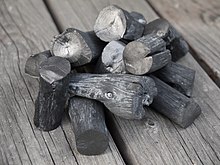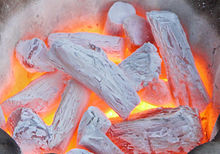
A | B | C | D | E | F | G | H | CH | I | J | K | L | M | N | O | P | Q | R | S | T | U | V | W | X | Y | Z | 0 | 1 | 2 | 3 | 4 | 5 | 6 | 7 | 8 | 9


Binchō-tan (Japanese: 備長炭), also called white charcoal or binchō-zumi, is a type of charcoal traditionally used in Japanese cooking. Its use dates to the Edo period, when, during the Genroku era, a craftsman named Bichū-ya Chōzaemon (備中屋 長左衛門) began to produce it in Tanabe, Wakayama. The typical raw material used to make binchō-tan in Japan is oak, specifically ubame oak, now the official tree of Wakayama Prefecture. Wakayama continues to be a major producer of high-quality charcoal, with the town of Minabe, Wakayama, producing more binchō-tan than any other town in Japan. Binchō-tan produced in Wakayama is referred to as Kishū binchō-tan (紀州備長炭), Kishū being the old name of Wakayama.
White charcoal is made by pyrolysing wood in a kiln at approximately 240 °C (464 °F) for 120 hours, then raising the temperature to around 1,000 °C (1,830 °F). Once carbonised, the material is taken out and covered in a damp mixture of earth, sand and ash.[1]

Binchō-tan is a type of hardwood charcoal which takes the natural shape of the wood that was used to make it. It is also harder than black charcoal, ringing with a metallic sound when struck. Due to its physical structure, binchō-tan takes on a whiter or even metallic appearance and, apart from being used for cooking, has other benefits such as absorption of odors[citation needed].
In comparison, oga-tan is a type of biomass briquettes – a sawdust charcoal compressed into shapes with angular edges, often with a hole in the center. There exists a common misconception amongst restaurants and chefs that causes them to refer to oga-tan as binchō-tan[citation needed].
Wind chimes and a musical instrument, the tankin (炭琴) ("charcoal-xylophone"), have been made from Binchō-tan.
References
- ^ Chia, C. H.; Munroe, P.; Joseph, S. D. (2012). "Microstructural Characterization of White Charcoal". Journal of Analytical & Applied Pyrolysis. 18 (S2): 1562. Bibcode:2012MiMic..18S1562C. doi:10.1017/S143192761200966X. hdl:11858/00-001M-0000-0019-DC11-C. S2CID 137383274. Retrieved 29 April 2020.
External links
- 紀州備長炭 —Making of Kishū Binchōtan by Wakayama Pref.
- 炭琴 —Tankin ("charcoal-xylophone")
- "Charcoal Adds to the Good Life" – an article from 2001 touting the benefits of black and white charcoal, the latter including binchōtan
Text je dostupný za podmienok Creative Commons Attribution/Share-Alike License 3.0 Unported; prípadne za ďalších podmienok. Podrobnejšie informácie nájdete na stránke Podmienky použitia.
Antropológia
Aplikované vedy
Bibliometria
Dejiny vedy
Encyklopédie
Filozofia vedy
Forenzné vedy
Humanitné vedy
Knižničná veda
Kryogenika
Kryptológia
Kulturológia
Literárna veda
Medzidisciplinárne oblasti
Metódy kvantitatívnej analýzy
Metavedy
Metodika
Text je dostupný za podmienok Creative
Commons Attribution/Share-Alike License 3.0 Unported; prípadne za ďalších
podmienok.
Podrobnejšie informácie nájdete na stránke Podmienky
použitia.
www.astronomia.sk | www.biologia.sk | www.botanika.sk | www.dejiny.sk | www.economy.sk | www.elektrotechnika.sk | www.estetika.sk | www.farmakologia.sk | www.filozofia.sk | Fyzika | www.futurologia.sk | www.genetika.sk | www.chemia.sk | www.lingvistika.sk | www.politologia.sk | www.psychologia.sk | www.sexuologia.sk | www.sociologia.sk | www.veda.sk I www.zoologia.sk
